

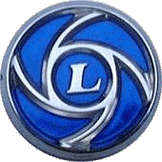
 |
 |
|||||||
© 2025 |
The Triumph Stag Buyer's Guide, by Tim BujaIn addition to the items listed in the general Triumph Buyer's Guide, there are a number of specific items of interest on the Stag.
What to look for when buying a StagThe Stag engine has proved to be its great weakness. Some people have even christened it the "Triumph Snag". The key problem with the Stag is its cooling system. To test it, you should let any potential purchase idle for 15 minutes (preferably on a hot day) while keeping an eye on the temperature gauge. Check that the radiator is as hot at the bottom as it is at the top. If it's not, there may be problems with coolant circulation and expensive damage may have already been done. In addition, check that the thermostat (in the intake manifold) hasn't been removed to mask some chronic cooling problem, and make sure that the oil pressure light is connected. If not, leave well enough alone. An overheating Stag will eventually end up with a warped head. Like the TR7 (which uses half of the Stag V8), Stag heads have a bad reputation for warping in service, often with as few as 25,000 miles. The blown gaskets which soon follow can lead to damaged head faces which will need skimming if they are to be rescued. The trouble is that Triumph only allowed 0.010" for removal before the head had to be replaced. In some cases, this is still not enough to save the head. A blown head gasket can also cause engine coolant to seep between the head and the studs. An electrochemical reaction between the aluminum head and the steel studs causes the head studs to seize in place, making head removal almost impossible since the studs and bolts used to attach the head to the block are not parallel. Some people have had to lift the car with an engine hoist and pound on the head studs with an air hammer, using the weight of the car to pull the studs through the head. Internal corrosion of the coolant passages is another problem if a corrosion-inhibiting coolant was not used. Mark II Stags originally came with a sheet metal radiator fan cowling to increase the efficiency of the radiator cooling fan. Many of the cowls were removed when the original engine mounts sagged, causing the engine driven radiator fan to rub against the cowl. Removal of the cowl solved the noise problem, but may have created an overheating problem. If your Stag doesn't have a radiator fan cowling, new composite cowls are now available. Visit the Triumph Stag Composite Radiator Cowl page for more information. Be aware that while these parts were modeled from a genuine MkII Stag cowling, they are being produced from composite polyester/fiberglass instead of the original sheet metal, and are not British Motor Heritage approved. If you have a 16.5" metal radiator fan, you should plan on replacing both of the front engine mounts to eliminate the possibility of the fan striking the cowl or the lower radiator hose. This is a major job - replacing the right engine mount requires you to remove the alternator, which requires removal of the anti-sway bar and automatic transmission oil cooler. Changing the left engine mount will require you to remove the exhaust manifold. Timing chains are another source of concern. The single-roller chains wear quickly and should be replaced every 25-30,000 miles. If they break or skip a tooth, the valves will embed themselves in the pistons. The hydraulic timing chain tensioners are actuated by the engine lube oil, so you must keep the idle rpm up high enough to maintain sufficient oil pressure. If you hear the timing chains rattle when you start the engine, but the noise goes away a few seconds later as the oil pressure comes up, plan on replacing the timing chains within the next 3000-5000 miles. If the rattle doesn't go away at idle, don't drive the car any further or you'll be facing a major repair bill in the very near future. You don't want to see the oil light come on at idle, since it means you have less than 5psi of oil pressure. Along with the TR7 engine, the Stag engine has a jackshaft that runs in the block. This shaft drives the water pump, distributor and oil pump. Both engines have shown a tendency to wear the bottom of the front jackshaft bearing surface in the block. This results in reduced oil pressure, and eventually, a seized jackshaft. A preliminary symptom of excessive front bearing wear is the failure of the water pump drive gears due to insufficient lubrication splashing out from the front jackshaft bearing. Some people simply replace the jackshaft and water pump, not realizing the root cause of the problem is the worn front jackshaft bearing. The only fix for this is to completely strip the engine and have the jackshaft bearings align-bored and resleeved. This wear is not apparent until the engine is torn down, and even then, some experienced engine rebuilders have missed it. The lack of an engine oil pressure gauge makes this problem even harder to spot. There was a brief period when crankshaft bearings wore out prematurely due to a temporary machining problem which resulted in the wrong surface finish on the crankshaft journals. If you have to regrind the crankshaft, make sure that it is properly hardened afterwards or you'll have a disaster in a very short time. Since the original factory hardening process only penetrated around 10-15 thousandths below the surface, you may remove all of the hardened surface with the first regrind. Premature wear could also occur as a consequence of poor maintenance, or if the engine (and hence, the oil) was running too hot as a consequence of cooling problems. The source of any fluids found on the top of the engine can be checked by cleaning the top of the engine with a pressure washer (or at a self-service car wash). Drive the car until it is hot enough to evaporate any water left on top of the block. When the engine is dry, place a couple of white paper towels between the intake manifold and the top of the block and let it sit for several hours. Coolant (green) may appear from a number of sources. A leaking water pump seal will cause coolant to leak out of an opening below the waterpump cover, on the flywheel side of the waterpump housing. The intake manifold gaskets are supposed to seal the fuel/air mixture flowing from the manifold into the heads, as well as coolant flowing from the heads into the manifold. These gaskets are notorious for allowing coolant leaks. Other coolant leak sources could be from the thermostat cover, bypass hose, or heater return hose. The water pump cover gaskets are well designed and rarely, if ever, leak. Fuel leaks may be from improperly adjusted carburetor floats or leaking needle valves. Oil leaks are probably from the camshaft cover gaskets. Test for suspension bushing wear in the usual manner by shaking each wheel sideways while a helper applies the brakes. If there is play, the suspension bushings may need to be replaced; if there is play with the brakes off, then suspect a wheel bearing. A trait common to Triumphs with semi-trailing arm rear suspension (Triumph 2000/2500, TR4A IRS, TR5, TR250, TR6) has developed the name "Triumph Twitch". This is a curious sideways lurch at the rear when you let off the throttle in the middle of a turn. This lurch doesn't always happen, but when it does, it's caused by the splines of the telescopic drive shafts sticking under power and then freeing in coast, thereby locking, then releasing the rear suspension. The official word from Triumph was that this is a lubrication problem that should not arise, though they did admit that it sometimes does occur. Contrary to popular opinion, the lurch is not caused by worn semi-trailing arm bushings. Several Stag parts houses in the UK have developed replacement halfshafts that use modern constant velocity joints that provide articulation, as well as compression and extension without the use of sliding splines. These new halfshafts eliminate the Triumph Twitch, but at a price - expect to pay $600+ for a pair! Like the TR6 that shares its manual gearbox, the Stag has a reputation for wearing out its synchromesh in second and third gears. They also tend to suffer from gearlever buzzes after a lot of use. The automatic transmission (Borg-Warner Type 35) tends to engage Reverse and Drive with a lurch if the idle speed is set too high. This problem can also be accentuated by worn driveshaft U-Joints. Reluctance to shift at speed can be caused by a poorly adjusted downshift cable. A metallic ping from the propellor shaft can be heard if the differential input flange bolts are loose. The differential has a good reputation, although they tend to whine as they age. Most new differentials whine from day one because a recent batch of ring & pinions appear to have been improperly hardened. Another source of drive line noise can come from the quill shaft bearing in the differential's pinion extension housing. If the differential pinion oil seal fails, the differential oil will flow into the extension housing and wash away the grease for the quill shaft bearing. A visible oil leak from the pinion flange area could mean future trouble. Power steering leaks may occur, but no more than on any other power-steered car. Inspect the rack gaiters for signs of oil leaks. Type F Automatic Transmission fluid should be used to top up the reservoir. If the rack leaks, it's best to have it professionally rebuilt. Replacement seal kits are available, but it seems that DIY repairs don't last long enough to be worth the trouble of doing it yourself. Note that the power steering pump must be unbolted to remove the battery, although the hoses stay connected. Brake troubles are rare. The convertible storage hold can leak, and if the top was not stored correctly, it can be very difficult to erect. Before the top is lowered into the hold, the rear section must be locked in the vertical position using the two latches provided. Failure to do this will cause the rear section to become trapped in the hold, although instructions are provided in the owner's manual on how to extract it. The tinworm can and does attack the Stag, and you should look for rust damage in the floorpan, fenders (inner and outer), rear fender/sill joints, rear subframe mountings, and the outriggers. Check these areas very carefully, for while replacement panels are available, they are expensive. It seems that post-1974 Stags are more susceptible to rust problems than are the earlier models due to the factory switching to a different sheet steel supplier.
Required (not just simply recommended) MaintenanceProper and timely maintenance is crucial for the longevity of a Stag. If you already own one, keep these tips in mind. If you're looking to buy one, read the following and then ask the owner about how it was maintained. The most important maintenance item on a Stag is an annual reverse flush of the cooling system, followed by replacing the coolant with a good quality anti-freeze with the proper corrosion inhibitor for aluminum engines. See the Annual Cooling Flush article for complete details. The flush will also help to remove the last bits of casting sand from the water passages in the block. This should be followed up by weekly (or even more frequent) checks of the coolant level in the expansion tank. You must maintain the correct coolant level, since the gear-driven water pump is mounted high in the engine. Even a small loss of coolant will drop the level below the point needed to maintain circulation. While you're changing the engine coolant, inspect all of the coolant hoses. For the last few years, OEM style reinforced hoses have been unavailable, and the only alternative was to use un-reinforced hoses. These hoses do not meet the construction standards set by British Standard Specification 5119, which covers automotive coolant hoses and states that all hoses used on cars must be reinforced. While the hose manufacturer claims that un-reinforced hoses are suitable for the Stag, the elevated temperatures and pressures present in the Stag's engine compartment make them marginal, at best. Even if your reinforced hoses appear in good condition, replace them every five years or 25,000 miles, whichever is sooner. If your Stag has overheated, replace them sooner. Always wipe off any gasoline, oil or solvent contamination as soon as possible. Unreinforced hoses should be replaced if they balloon when hot, or take a permanent balloon when cold. Since the wall thickness of unreinforced hoses is more inconsistent than reinforced hoses and tend to be thinner on the outsides of bends, there is a higher failure rate at these points. Carefully inspect these hoses on the outside of the bends, using thumb pressure to check for variations in the wall thickness. Reinforced coolant hose sets are now available again, starting at $40 and up. Next, plan on changing the oil and filter every 3,000 miles and checking the timing chains every 25,000 miles. Once they start to rattle, there's a danger of jumping a tooth or breaking a chain. The Stag engine is not a freewheeling design - the pistons will collide with open valves if a timing chain breaks or if the camshaft timing is off. These destructive encounters between valves and pistons are very expensive... It's important to keep the rear axle breather clear. Clogging here can cause the oil to overheat and escape through the seals, with the consequent danger of seizure. The breather is on the top of the differential casing, near the right rear corner. Check that the pin is loose in the breather hole. Driveshafts need a regular shot of the correct grease to keep the sliding splines from becoming worn, or in the worst case scenerio, seized. Replacements are expensive. If there are any signs of overheating from whatever cause, do not attempt to drive any further. The Stag, with its very heat-sensitive alloy heads and lubrication system, will not see you to your destination before suffering expensive engine damage.
BibliographySeveral magazines have had articles on the Stag. Try looking here for additional information:
Some books worth noting:
Copyright © by Triumph Stag Club USA All Right Reserved. Last Updated: 2016-04-07
|
6/7/2025   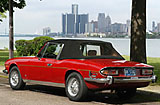 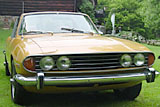 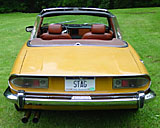 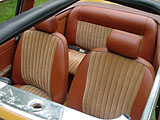  | ||||||